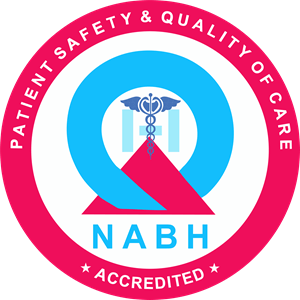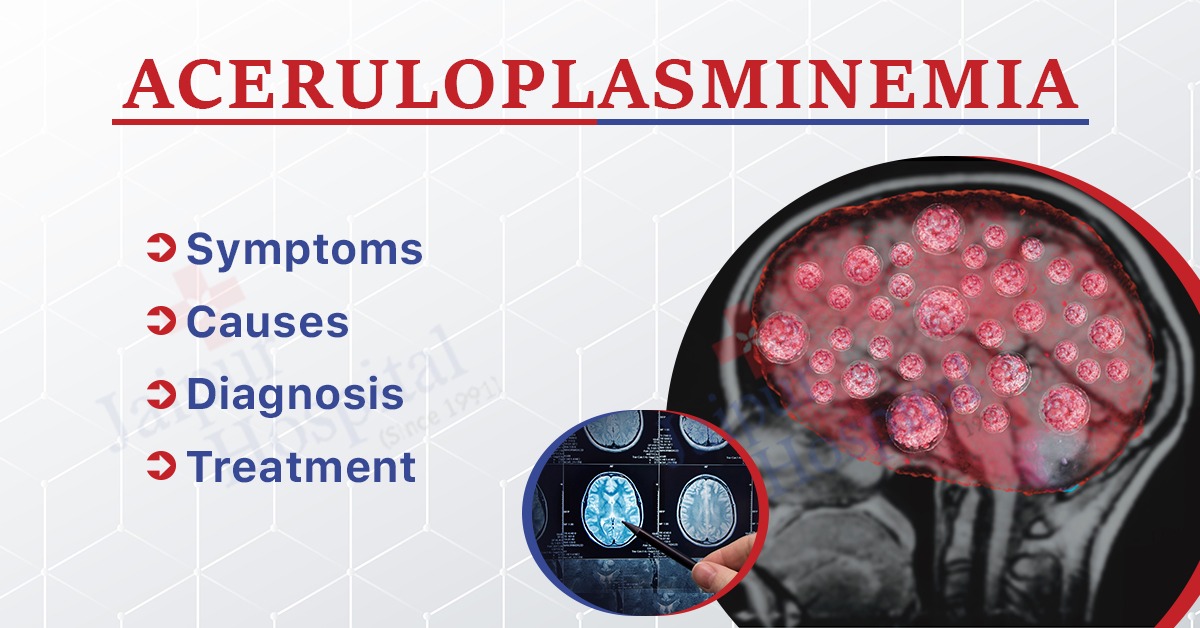What is Aceruloplasminemia?
Aceruloplasminemia is an uncommon genetic condition characterized by the lack or insufficiency of ceruloplasmin, a vital protein for regulating iron levels in the body. The liver primarily produces ceruloplasmin. Has a crucial role in transporting and managing iron throughout our system. When ceruloplasmin is deficient or absent it can lead to iron accumulation in different organs and tissues resulting in several health complications.
Given its rarity aceruloplasminemia necessitates specialized medical attention that often involves a team of healthcare experts such, as geneticists, hematologists, and neurologists. This multidisciplinary approach addresses the aspects of this disorder effectively.
Symptoms of Aceruloplasminemia
Aceruloplasminemia is a rare genetic disorder caused by the absence or deficiency of ceruloplasmin, a protein that plays a crucial role in iron metabolism. The symptoms of aceruloplasminemia can vary from person to person, but they are primarily related to the accumulation of iron in various organs and tissues in the body. Common symptoms and complications associated with aceruloplasminemia may include:
Neurological Symptoms:
○ Movement disorders, such as dystonia (involuntary muscle contractions), chorea (jerky, involuntary movements), or parkinsonism (tremors, rigidity, and bradykinesia).
○ Cognitive impairment, including problems with memory, attention, and decision-making.
○ Psychiatric symptoms, such as depression and anxiety.
○ Neuropathy, which can lead to sensory or motor disturbances.
● Liver Damage:
○ Iron accumulation in the liver (hepatic iron overload) can damage liver and lead to symptoms such as hepatomegaly (enlarged liver), abdominal pain, and abnormal liver function tests.
● Diabetes:
○ Iron buildup in the pancreas can lead to diabetes mellitus, causing symptoms like increased thirst, frequent urination, and unexplained weight loss.
● Anemia:
○ Iron accumulation in the bone marrow can interfere with the production of red blood cells, leading to anemia (low red blood cell count). Anemia can cause fatigue, weakness, and pale skin.
● Retinal Degeneration:
○ Aceruloplasminemia can lead to retinal degeneration, resulting in visual impairment and vision problems.
● Other Symptoms:
○ Cardiac problems in some cases are due to iron accumulation in the heart.
○ Skin changes, such as hyperpigmentation or the appearance of blue-gray deposits in the skin.
○ Osteoporosis (brittle bones) or bone pain in some individuals.
It’s important to note that the severity and combination of these symptoms can vary among individuals with aceruloplasminemia. The condition is typically diagnosed through genetic testing and assessment of ceruloplasmin levels in the blood. While there is no cure for aceruloplasminemia, treatment options aim to manage symptoms, reduce iron accumulation, and improve the quality of life for affected individuals.
Causes of Aceruloplasminemia
Aceruloplasminemia is mainly caused by changes that impact how ceruloplasmin, a protein that binds to copper and is produced in the liver is produced or works. Ceruloplasmin plays a role, in managing iron levels in the body by helping transport iron through the bloodstream and preventing iron buildup in different organs and tissues. When ceruloplasmin is deficient or doesn’t function properly due to changes it leads to the accumulation of iron in the body resulting in symptoms and complications associated with aceruloplasminemia.
The genetic basis of aceruloplasminemia involves mutations in the CP gene, which gives instructions for producing ceruloplasmin. These mutations can be inherited following a pattern. This means that individuals with aceruloplasminemia inherit two mutated CP genes, one from each parent. If someone inherits one mutated gene, alongside one gene they are carriers but don’t usually experience symptoms of the condition.
The specific mutations in the CP gene can vary among affected individuals, and different mutations may lead to variations in the severity and presentation of aceruloplasminemia.
It’s important to note that aceruloplasminemia is a very rare disorder, and because it is genetic, it can run in families. If there is a known family history of the condition, genetic counseling may be recommended to assess the risk of passing on the mutated CP gene to future generations. Genetic testing can also be performed to confirm the presence of the mutation in affected individuals or carriers.
Diagnosis of Aceruloplasminemia
The diagnosis of aceruloplasminemia typically involves a combination of clinical assessments, laboratory tests, and genetic testing. Given the rarity and complexity of the condition, a specialized medical team, including geneticists, hematologists, and neurologists, often collaborates to make an accurate diagnosis. Here are the key steps involved in diagnosing aceruloplasminemia:
- Clinical Evaluation: Medical professionals will perform a thorough clinical evaluation, including a review of the patient’s medical history and a physical examination. They will be looking for signs and symptoms associated with the condition, such as neurological abnormalities, liver dysfunction, diabetes, and other related issues.
- Blood Tests: Blood tests are a crucial part of the diagnostic process. Specific blood tests help in identifying abnormal iron metabolism and assessing ceruloplasmin levels. Low ceruloplasmin levels in the blood are a hallmark of aceruloplasminemia. Additional blood tests may be performed to assess iron levels, liver function, and other parameters.
- Brain Imaging: Neuroimaging studies, such as magnetic resonance imaging (MRI), may be used to examine the brain for signs of iron accumulation. Aceruloplasminemia can result in iron buildup in the brain, and this can be visualized through imaging techniques.
- Ophthalmological Evaluation: Ophthalmological assessments, including retinal examination, may be conducted to check for signs of retinal degeneration, which is common in aceruloplasminemia.
- Genetic Testing: Genetic testing is essential to confirm the diagnosis of aceruloplasminemia. DNA analysis of the CP gene is performed to identify specific mutations that cause the deficiency or dysfunction of ceruloplasmin. This genetic testing can provide a definitive diagnosis and help determine the inheritance pattern.
- Other Investigations: Depending on the individual’s symptoms and the extent of iron accumulation, additional tests or evaluations may be needed to assess the impact of aceruloplasminemia on various organs and tissues. This could include liver biopsies or bone marrow examinations.
- Differential Diagnosis: Given the overlap of some symptoms with other medical conditions, healthcare professionals may also consider differential diagnoses to rule out other potential causes of the patient’s symptoms.
Also read: Asperger Syndrome: Symptoms, Causes, Diagnosis, Treatment, and Prevention
Complications of Aceruloplasminemia
Complications may occur as a result of the accumulation of iron in various organs and tissues owing to the progression of aceruloplasminemia. However, such complications usually depend on their severity and may occur in a single or multiple form in different persons, even those who are affected by the same disease. Common complications associated with aceruloplasminemia include:
● Neurological Complications:
○ Movement Disorders: Aceruloplasminemia is experienced by many persons as a movement disorder which could be dystonia, chorea, or parkinsonism which results in trembling, rigidity, and bradykinesia.
○ Cognitive Impairment: The cognitive ones may involve ineffective memory, challenges in focus, and poor decision-making.
○ Psychiatric Symptoms: Acromegaly is associated with depression and psychotic disorders, and these include depression and anxiety as well.
○ Neuropathy: This may cause peripheral neuropathy with a sensory or motor involvement of extremities.
● Liver Damage:
○ Hepatic Iron Overload: The iron deposits in the liver cause liver damage leading to hepatomegaly (enlarged liver), abdominal pain, and abnormal liver function tests.
● Diabetes:
○ Pancreatic siderosis may eventually beget diabetes mellitus characterized by polydipsia with polyuria and unexpected loss of weight.
● Anemia:
○ The iron deposit in the bone marrow impairs the formation of erythrocytes resulting in anemia. Anemia gives rise to tiredness, enfeeblement, and palliness of the skin.
● Retinal Degeneration:
○ Retinopathy associated with aceruloplasminemia may lead to compromised seeing and eyesight problems.
● Cardiovascular Complications:
○ This may lead to problems associated with the heart such as cardiomyopathy (a condition where one has an enlarged or weakened heart muscle) and arrhythmia (where a person develops irregular heartbeats).
● Other Complications:
○ Skin Changes: Others might experience dermal abnormalities like hyperpigmentation and blue-gray deposits on the skin.
○ Osteoporosis: Iron deposits in the bone tissue may result in brittle bones as well as bone pain in certain instances.
Also read: Acrodysostosis: Causes, Symptoms, Complications, and Treatment
Treatment of Aceruloplasminemia
The treatment of aceruloplasminemia primarily aims to manage the symptoms, slow down the progression of the disease, and reduce the excess iron buildup in the body. Since aceruloplasminemia is a rare and complex disorder, management often involves a multidisciplinary medical team, including geneticists, hematologists, neurologists, and other specialists. Here are some key aspects of the treatment and management of aceruloplasminemia:
● Phlebotomy (Blood Removal):
○ Phlebotomy, also known as therapeutic phlebotomy, is a common treatment approach to reduce excess iron levels in the body. It involves removing a specific volume of blood regularly, typically every few weeks, to lower the iron burden. The frequency and volume of phlebotomies may be adjusted based on the individual’s iron levels and response to treatment.
● Iron-Chelation Therapy:
○ Chelation therapy may be considered in cases where phlebotomy alone is not sufficient or feasible. Chelation therapy involves the use of medications that bind to iron and help remove it from the body. Medications like deferoxamine, deferiprone, or deferasirox may be prescribed. The choice of chelating agent and dosages will be determined based on individual needs.
● Symptomatic Management:
○ Depending on the specific symptoms and complications experienced by the individual, symptomatic management may include medications to address movement disorders, psychiatric symptoms, and other neurological issues.
○ For diabetes management, medications or insulin therapy may be required.
● Ongoing Monitoring:
○ Regular monitoring of iron levels, liver function, and other relevant parameters is crucial to assess the effectiveness of treatment and make necessary adjustments.
○ Neurological and psychiatric symptoms should be closely monitored to provide appropriate care and support.
● Genetic Counseling:
○ Genetic counseling is important for individuals with aceruloplasminemia and their families to understand the genetic basis of the condition, assess the risk of passing it on to future generations, and discuss family planning.
● Supportive Care:
○ Supportive care measures can include physical therapy, occupational therapy, and speech therapy to address movement and cognitive issues.
○ Psychological support and counseling can help individuals and their families cope with the emotional and psychological aspects of living with a rare and complex disorder.
Conclusion
Aceruloplasminemia is a very rare genetic disorder, where the body lacks/or hardly produces ceruloplasmin, a protein essential, in the regulation of iron. With that said, this condition causes the buildup of iron in different organs and components within an individual over time, which poses different consequences.
Diagnosis of the condition includes clinical evaluation, blood tests for measuring ceruloplasmin levels as well as iron metabolic function, radiological examination, and identification of CP gene mutations. To plan for and start relevant treatment, a definite diagnosis is necessary.
The diseases that are associated with movement disorders, intellectual problems, liver failure, diabetes mellitus, anemia, retinopathy, heart attacks, etc., are called Aceruloplasminemia. It is a multifaceted and progressive condition, hence there is a multidisciplinary medical team working together in symptom management and reduction of iron overload. There are several treatment methods such as phlebotomy to eliminate excessive iron, chelate therapy on iron, palliative measures, and frequent assessment of health status.
It involves supportive care and genetic counseling too. However, therapy does not entail a cure but instead focuses on the improvement of quality of life, slowing down the spread of the disease, and prevention or management of complications. Specialists, for example, are sometimes needed for managing aceruloplasminemia because not every patient requires an adequate course of medications or any other type of therapy for optimal health status.


